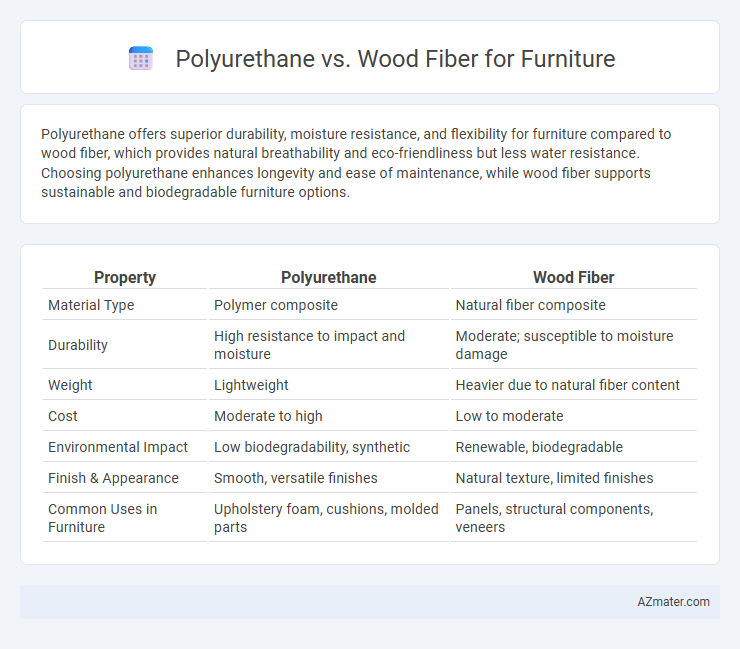Polyurethane offers superior durability, moisture resistance, and flexibility for furniture compared to wood fiber, which provides natural breathability and eco-friendliness but less water resistance. Choosing polyurethane enhances longevity and ease of maintenance, while wood fiber supports sustainable and biodegradable furniture options.
Table of Comparison
| Property | Polyurethane | Wood Fiber |
|---|---|---|
| Material Type | Polymer composite | Natural fiber composite |
| Durability | High resistance to impact and moisture | Moderate; susceptible to moisture damage |
| Weight | Lightweight | Heavier due to natural fiber content |
| Cost | Moderate to high | Low to moderate |
| Environmental Impact | Low biodegradability, synthetic | Renewable, biodegradable |
| Finish & Appearance | Smooth, versatile finishes | Natural texture, limited finishes |
| Common Uses in Furniture | Upholstery foam, cushions, molded parts | Panels, structural components, veneers |
Introduction to Polyurethane and Wood Fiber in Furniture
Polyurethane, a versatile synthetic polymer, offers durability, flexibility, and moisture resistance, making it a popular choice for modern furniture manufacturing. Wood fiber, derived from natural wood particles compressed into boards, provides eco-friendly, cost-effective, and sustainable solutions with good structural strength. Both materials cater to different design needs, with polyurethane excelling in cushioning and finish, while wood fiber emphasizes rigidity and environmental benefits.
Material Composition: Polyurethane vs Wood Fiber
Polyurethane is a synthetic polymer composed of organic units joined by carbamate (urethane) links, providing high durability, flexibility, and resistance to moisture and chemicals. Wood fiber, derived from natural wood cells, consists mainly of cellulose, hemicellulose, and lignin, offering eco-friendly, biodegradable properties but less resistance to water and mechanical wear. The chemical composition of polyurethane grants superior longevity and cushioning for furniture, while wood fiber emphasizes sustainability and natural aesthetics.
Durability and Longevity Comparison
Polyurethane furniture offers superior durability due to its resistance to moisture, scratches, and general wear compared to wood fiber, which is more prone to swelling and damage over time. Wood fiber furniture, while aesthetically pleasing and eco-friendly, typically requires more maintenance to retain structural integrity and appearance. Longevity of polyurethane materials generally exceeds that of wood fiber by years, making it a preferred choice for high-traffic or moisture-prone environments.
Aesthetic Appeal and Design Versatility
Polyurethane offers high design versatility with its ability to be molded into intricate shapes and painted in various finishes, providing a smooth, modern aesthetic ideal for contemporary furniture. Wood fiber, while more limited in form flexibility, delivers a warm, natural appearance with unique grain patterns that enhance the visual texture and character of furniture pieces. Both materials cater to different design preferences, where polyurethane excels in sleek, customizable designs and wood fiber appeals to classic, organic styles.
Comfort Level in Furniture Applications
Polyurethane foam offers superior cushioning and resilience, making it ideal for furniture that requires high comfort levels and prolonged support. Wood fiber, while environmentally friendly and breathable, tends to be firmer and less adaptive to body contours, which can reduce overall comfort in seating applications. Furniture designers often choose polyurethane for areas needing plush softness and wood fiber for structural or eco-conscious elements.
Environmental Impact and Sustainability
Polyurethane furniture often relies on petrochemicals, resulting in higher carbon emissions and limited biodegradability, whereas wood fiber products are typically more sustainable, sourced from renewable forests with a lower environmental footprint. Wood fiber materials contribute to carbon sequestration, promoting a circular economy through biodegradability and recyclability, while polyurethane's synthetic composition tends to persist in landfills for decades. Sustainable forestry certifications like FSC or PEFC for wood fiber further enhance environmental benefits, making it a preferable choice for eco-conscious furniture manufacturing.
Cost Analysis: Polyurethane vs Wood Fiber
Polyurethane furniture typically incurs higher upfront costs due to advanced manufacturing and durability features, whereas wood fiber furniture offers a more budget-friendly option owing to its natural material composition and simpler production methods. Maintenance expenses for polyurethane remain lower over time because of its resistance to moisture and wear, contrasting with wood fiber's potential for higher upkeep costs linked to susceptibility to damage and environmental factors. Considering lifecycle costs, polyurethane presents better long-term value despite initial investment, while wood fiber is preferable for cost-sensitive projects prioritizing immediate affordability.
Maintenance and Care Requirements
Polyurethane furniture offers superior resistance to stains, moisture, and general wear, requiring minimal maintenance such as occasional dusting and wiping with a damp cloth. Wood fiber furniture, while eco-friendly and breathable, demands regular care including polishing and protection from excessive humidity to prevent warping or cracking. Choosing polyurethane reduces the need for frequent upkeep, whereas wood fiber requires consistent attention to preserve its natural texture and longevity.
Common Uses in Modern Furniture
Polyurethane is widely used in modern furniture for upholstery and cushioning due to its durability, flexibility, and resistance to wear, making it ideal for sofas, chairs, and mattresses. Wood fiber, often found in engineered wood products like MDF and particleboard, serves as an eco-friendly and cost-effective material for structural components, shelves, and cabinetry. Both materials complement contemporary furniture designs, balancing comfort with sustainability and practicality in residential and commercial settings.
Choosing the Right Material for Your Needs
Polyurethane offers durability, resistance to moisture, and easy maintenance, making it ideal for furniture in high-traffic or humid environments, whereas wood fiber provides natural aesthetics, breathability, and eco-friendliness, appealing to those prioritizing sustainability and organic textures. Consider polyurethane for modern designs requiring longevity and low upkeep, while wood fiber suits classic styles emphasizing warmth and environmental impact. Evaluating factors such as room conditions, stylistic preferences, and long-term usage helps determine the optimal material choice for your furniture needs.

Infographic: Polyurethane vs Wood fiber for Furniture
 azmater.com
azmater.com